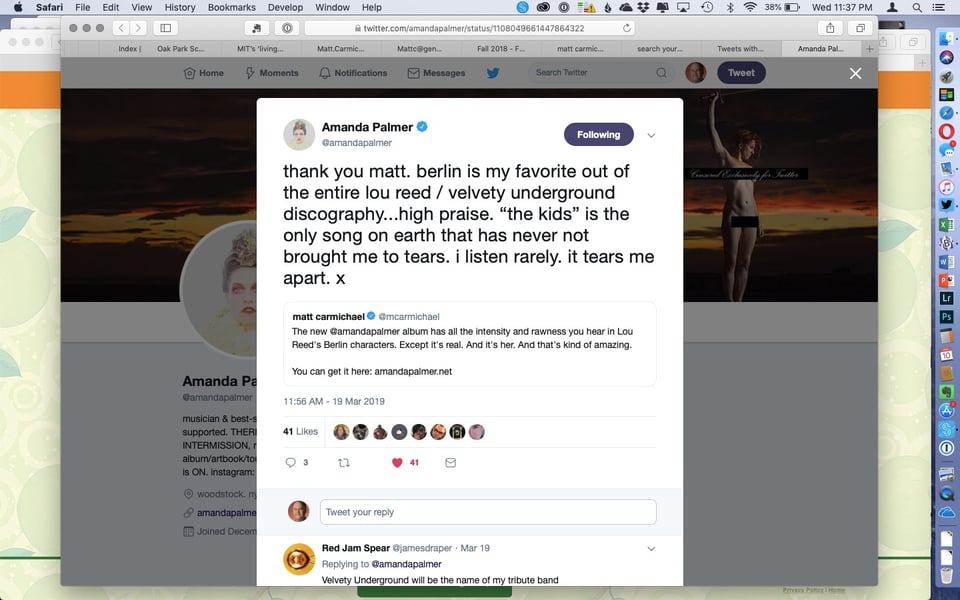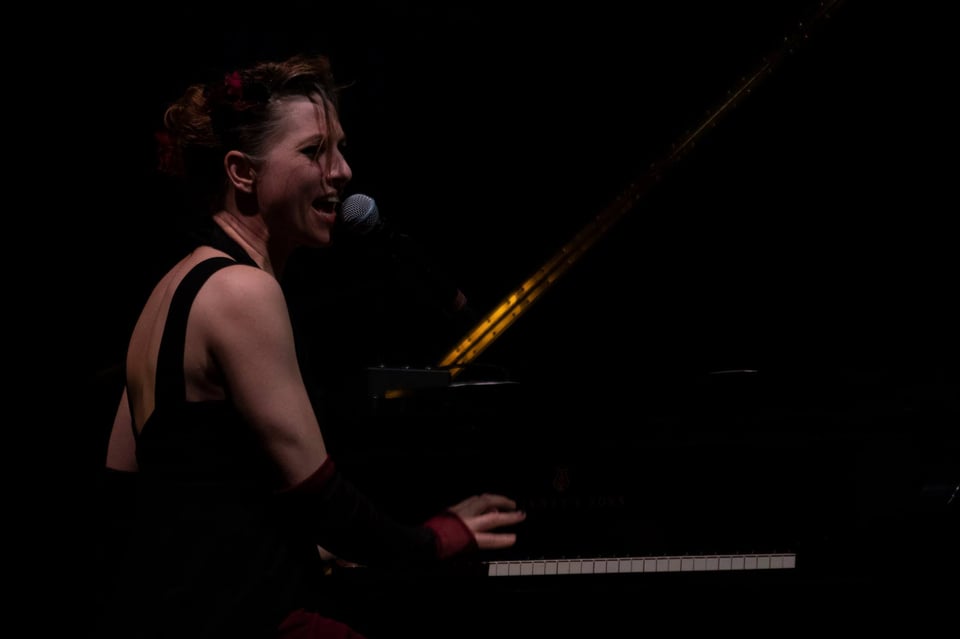Meeting Amanda Palmer
Meeting my Heroes is an occasional essay series from Matt Carmichael.
One of the most amazing text messages I ever got read, “hey! it's amanda effing palmer. running a tad late: 2:10 ok?”
How did I get here?
I think my first outreach was through Twitter. Just trying to get on her radar. I tweeted how much her album There will be no Intermission reminded me of Lou Reed’s Berlin. Which if you know me, is a high compliment. She tweeted back her appreciation.

[Side note: Twitter used to be such an amazing platform full of interesting people, and many of them would genuinely interact with you. Amanda Palmer, will.i.am, Jared from Subway (which didn’t age well. doh), Little Steven, William Gibson, Kenny Lofton from the Cubs, The Polyphonic Spree, Edward Tufte, Kai Ryssdal, Craig of Craigslist, my dad… I had conversations with them all. As well as lots of other folks who often became actual friends.]
I reached out to Amanda Palmer to interview her for the Beauty issue of What the Future. We liked to have a “pivot” at the end of each issue to take you in a slightly different direction. For the Mobility issue, we did an interview about the future of the Great American road trip. For Beauty we moved from physical beauty, which was the subject of most of the issue and into more ephemeral “art as beauty.” Amanda Palmer seemed a good subject to have that discussion, especially as she had gone to a self-funded model supported by fans through the Patreon platform.
We had our initial conversation backstage at her Chicago tour date and discussed what kind of survey question she would like to ask. She wanted other know if people felt more beautiful when surrounded by beautiful things like art and architecture and nature (they do) or surrounded by beautiful people (they do not.)
I shot the show, which was a treat, as was getting to do part of the interview in person.

It had been a while.
But throughout my career I’ve tried to tie in the things I love and the thing I’m good at and apply all of that and all of this (waves hands at this entire project). I’ve written about music for Ipsos. I tried to interview Bowie as a “marketer of the year” for AdAge (he declined the honor) and did write about his online art gallery, Bowieart.com. Through the site I bought one of his Tarot Card series of lithographs, which they offered to upgrade to a signed version but stupid ethics made me decline. I had photos (including an impromptu shot of Oprah) appear in Crain’s when I worked there. And perhaps most insane, I got will.i.am to write a column about “communiting” for AdAge. That led to a pitched battle with my copy desk which insisted on running a disclaimer after will.i.am insisted on us running the column as-is with his… unique sense of punctuation and capitalization.
It was great to meet Palmer. And to see her art in person again (I’d shot the Dresden Dolls back in the day.) It was great to shoot the show and use those photos in WTF.
And it was a fantastic conversation, as I’d imagined it would be (see below.)
I’d also interviewed her friend, Zoe Keating WTF and I mentioned that if Palmer thought the interview was fun and the free survey question was a good experience maybe she could put in a good word for me with someone else she and Zoe knew, whom I dearly wanted to interview. I hoped she would realize that I wasn’t trying to use her for her connections, but that I also would appreciate her connections. There’s a nuance but a critical one there. I figured if anyone would get that, it would be the author of a book called, “The Art of Asking: How I Learned to Stop Worrying and Let People Help.”
In the end, I didn’t get that other interview. As you’ll see next, that turned out to be OK, maybe. Here’s the interview, which did indeed take place at 2:10.
If beauty is art, how do we fund more of it?
The text message came in before the interview: “It’s Amanda effing Palmer. Running a tad late.” This is 100% on-brand for the singer/performer. From her early days as a street performer, to her time with the Dresden Dolls, to her TED talk and subsequent best-selling book “The Art of Asking,” to her current album (which NPR called “a grand statement of empathy”), Palmer commands attention. Her rapt community of followers on the Patreon crowd-funding platform (15,000 strong, each pledging about $3 per month, she says) support her financially and emotionally. The emotional part isn’t a one-way street. When she asks What the Future, she is thinking about the role of art in beauty and the rapidly changing relationship between the artist and arts funding.
WTF: You asked if people feel more beautiful when surrounded by beautiful things and beautiful people. The answers, generally speaking were “yes” and “no” respectively. What did you think of those results?
Amanda effing Palmer: The more I’ve moved through the world, the more I have proof positive that what I see with my eyes really does affect my state of mind. I don’t just mean the other emotional human beings pottering around. I mean whether I can see the sky, whether there are large, clean uncluttered spaces, whether they be nature or a table surface. What’s so interesting about all of this is that beauty is completely subjective. WTF: Yet people don’t feel more beautiful when surrounded by beautiful people.
Palmer: I would say that there are two definitions of beautiful people. They’re superficially beautiful people who get paid money to model sports clothes, and then there are internally beautiful people. When I’m around internally beautiful people, I feel infinitely more internally and externally beautiful myself.
WTF: In our global study people tended to prioritize “internal” beauty, but also had a very consistent definition of external beauty. Palmer: Well, we are mammals and we are definitely set with internal systems for procreation and what looks tasty. It’s just a thing.
WTF: Eighty percent of people find nature beautiful, and two-thirds say they always or often find music beautiful. Others find art in architecture or literature. This would seem to make a case for making more beautiful art. Palmer: It doesn’t mean anything unless we agree on a definition of beautiful, right? But there’s a lot of argument that I could make where all art is just beautiful by virtue of being fucking art. The more I work in the arts I’m reminded how far we have gotten from the source of why human beings started creating art for one another to begin with: It helps us. It connects us. It fortifies us. It feeds us. WTF: Can you talk a little about your Patreon community and how that relationship is changing between you as an artist and your fans as a funding source?
Palmer: I’ve been making art and trying to pay rent for 20 years. As someone who came out of the punk culture and the folk culture that really abhorred the commercialization of art, the more I move through the world nowadays the weirder I feel, because the younger generation coming up does not have the same relationship to “selling out” that my whole generation did. It’s super-disorienting because we don’t share a common language anymore.
WTF: How do you balance the commercial aspects of making a living and the art itself?
Palmer: I feel about commercial work the same way I feel about feminism: I am completely 1,000% pro-choice. I cannot and would not judge Lou Reed for doing a Honda ad or Bob Dylan for doing a Victoria’s Secret ad or for Patti Smith if she decides to do a complete about-face and—I don’t know, what would Patti Smith advertise? Space X? Tampons? Moleskine journals? Who knows? I respect the decision of any artist to figure out how to play the game any way they want.
WTF: If “selling out” is less of a problem, that could open the door for brands to be a larger part of funding the arts, by aligning with artists and musicians who fit their aesthetic or message, or appeal to their audiences.
Palmer: I think some of them do. I mean, look at how [rock band] OK Go paid for their last few videos [through brand partnerships]. Or the fact that Red Bull has a music festival that gives experimental musicians work. Every single artist is going to have to make a choice to whom they want to be beholden. That’s the critical issue.
WTF: And now you’re funded directly from your fans. Palmer: My relationship with these people is real. Their relationship with me is real. I just spent my morning writing a thank you letter to all 20,000 people who came to my spring tour to remind them that I know that I’m doing it for them, and they are showing up for me, and that this isn’t random. WTF: Much of your current art is finding beauty in pain. I’m paraphrasing a bit, but you’ve said that the audience isn’t there to validate your pain, they’re there because they have their own issues in their lives that they’re dealing with, and somehow your show helps. Have you figured out how that exchange works?
Palmer: I think human being mammals desperately need to feel un-alone and need to feel our experiences and losses, and our difficulty is reflected in one another. We forget how practically applicable art can be in our lives. We forget that the reason our ancestors came up with this bizarre idea in the first place was to help each other to make sense of the world, to make sense of pain, to make sense of the dark. Art is a fantastic vessel to carry that message of un-aloneness from one to the other.
